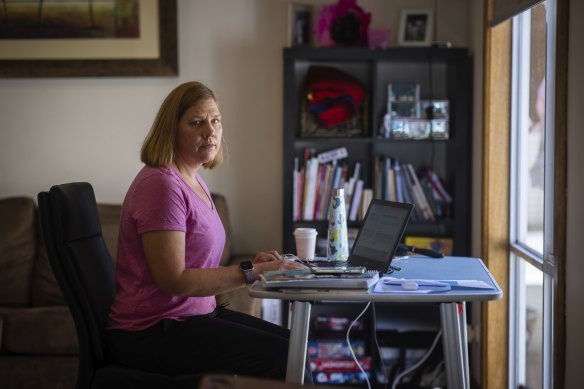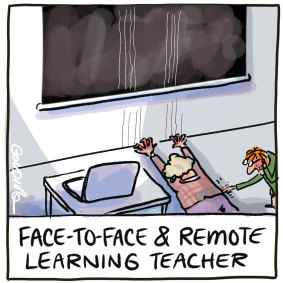By Adam Carey and Anna Prytz
This week’s full resumption of face-to-face lessons has instead been a case of remote learning redux for primary school teacher Cyndi Smith.
One of her students tested positive to COVID-19 on Monday – the first day all year levels were back on-site – forcing Ms Smith and the rest of her year 5/6 composite class into isolation. She has been teaching them online this week while she quarantines at home.

Primary school teacher Cyndi Smith is in seven-day isolation and teaching from home. Her students are in 14-day isolation so won’t be able to return to school with her on Monday.Credit: Paul Jeffers
Ms Smith, who teaches at a school in Melbourne’s east, will be free to go back to school on Monday to resume face-to-face lessons but most of her students won’t join her.
They are under 12, unvaccinated and therefore confined to isolation for another week. It means Ms Smith will have to juggle a hybrid in-person and virtual classroom.
“I’m going to have five or six kids who can come to school, so I’ll still need to provide remote learning to kids who need to do 14 days [quarantine],” Ms Smith said.
“I don’t know how I’m going to do that yet … I think I’m going to teach as normal and put my camera on for the kids to watch.”
Victorian schools have reopened after another long lockdown but children aged nine and under make up one in five current COVID-19 cases, spoiling their reunions with friends and further disrupting their education.
Four-hundred and thirty Victorian schools have been exposed to a COVID-19 case so far this term, according to daily data published by the Department of Education and Training and collated by lobby group the Committee for Public Education.
Forty-four of Melbourne’s 337 Catholic schools reported a positive case this week.
Health guidelines no longer require schools to shut for 14 days when this happens. The current school operations guide says schools can reopen in as little as 24 hours. Some schools have avoided having to close at all.
But the guide is silent on how schools can assist students who must isolate.
Parents Victoria executive officer Gail McHardy said the Education Department had been clear with the public that once students went back to school, remote learning would not be provided for children whose parents kept them home.

Credit: Illustration: Matt Golding
“But the difficulty we have is that now adults are vaccinated, it is the younger generation who are all vulnerable and that’s creating more disruption,” she said.
“At least when we were all in remote learning you knew the routine, even though it was still hard.”
Victorian Principals Association president Andrew Dalgleish said schools were adopting hybrid learning models, but it was “a nigh-on impossible task” for teachers to provide face-to-face and online learning simultaneously.
The 14-day isolation protocol is also creating tension between principals and parents who cannot go to work because a primary school-aged child is isolating at home, he said.
”It is completely dysfunctional and cruel and pressure needs to be exerted on the government and Health Department to ensure this 14-day hard lockdown is reduced significantly as soon as possible,” parent Chris Wiltshire said.
Streeton Primary School acting principal Leon Bell said the reopening of classrooms had been a happy time for students, though his staff had done a lot of work to address families’ anxieties.
Mr Bell said he prioritised mental health and physical fitness, which had been affected by lockdowns, and has communicated contingency plans for a school closure and student quarantines.
“It’s a question of when not if, so it’s important we are prepared to go straight into a different scenario,” he said.
“If we’re prepared then we can accommodate it. If it’s a whole class in isolation for two weeks then that teacher is prepared to switch back to remote learning.”
Mr Bell said individual students in isolation would be supported and helped to stay connected remotely.
Dr Christine Grove, an educational and developmental psychologist and researcher at Monash University, said despite schools reopening, students are still very much living in and coping with the pandemic.
“What we’re seeing on the ground now is students struggling to reconnect with friends and struggling with that social aspect of being back in the school environment,” she said.
Dr Grove said students who went through the added disruption of quarantine needed extra attention upon returning to class.
“We need to be mindful of them being back into that transition and knowing it will be tough and will take some time to readjust.
“We can accommodate their needs even with planning the classroom seating strategically to support students who have gone into iso and come back so that they’re sitting in a place where they feel safe in the classroom.”
An Andrews government spokesperson said it was working with the public health team on further measures around managing close contacts, to limit disruption to school and keep Victorian kids in the classroom.
“When students are required to isolate, they will be supported in the same way as students who are absent for extended periods of time due to illness or injury with materials to support their learning while they are at home,” the spokesperson said.
Fascinating answers to perplexing questions delivered to your inbox every week. Sign up to get our new Explainer newsletter here.